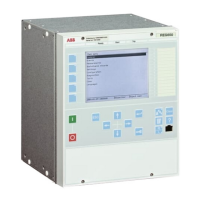third-harmonic voltage phasors U
3N
and U
3T
). The value of E3 should be close
to the following value:
( ) ( )
2 2
3N 3T 3T
E3 U U cos(ANGLE) U sin(ANGLE)= - × + ×
EQUATION2070 V1 EN (Equation 30)
2. Read the value of DU (differential voltage). The value of DU should be close to
the following value:
( ) ( )
2 2
3N 3T 3T
DU U U cos(ANGLE) U sin(ANGLE)= + × + ×
EQUATION2071 V1 EN (Equation 31)
3. Decrease the value of the injected voltage U
3N
until the signal START3H is
activated. Check that
EQUATION2072 V2 EN (Equation 32)
considering stated accuracy (beta is a setting parameter)
4. Increase the voltage U
3N
so that the sart signal falls. After that, switch the voltage
U
3N
to zero and measure the time delay for the activation of the signals TRIP and
TRIP3H.
The 100% stator earth fault protection also has a fundamental frequency neutral
point overvoltage function (95% stator earth fault protection). This part of the
protection can be tested separately by means of fundamental frequency voltage
injection from a test equipment.
6.6.5.2 Verifying settings
1. With the generator rotating at rated speed but not connected: check the value of
the following analogue signals: E3 (the magnitude of the 3
rd
harmonic induced
voltage in the stator), U
3N
(the magnitude of the third-harmonic voltage
measured at the neutral side of the generator), U
3T
(the magnitude of the third-
harmonic voltage measured at the terminal side of the generator) and ANGLE
(the angle between the third-harmonic voltage phasors U
3N
and U
3T
). The value
of E3 should be close to the following value:
( ) ( )
2 2
3N 3T 3T
E3 U U cos(ANGLE) U sin(ANGLE)= - × + ×
EQUATION2076 V1 EN (Equation 33)
Make sure that ANGLE has a value bigger than 125°
2. Read the value of DU (differential voltage). The value of DU should be close to
the following value:
1MRK 502 049-UEN A Section 6
Testing functionality
87
Commissioning manual

